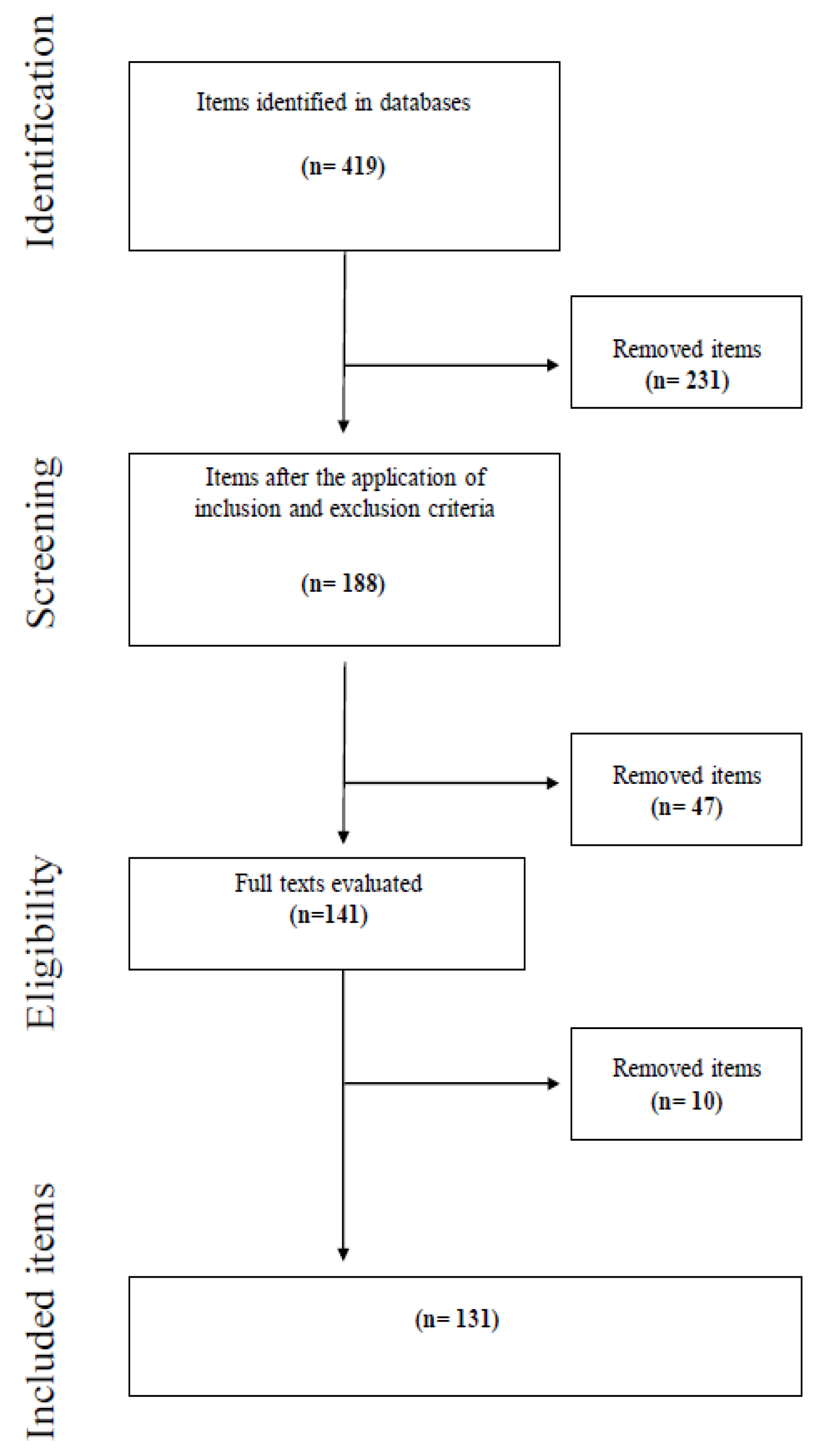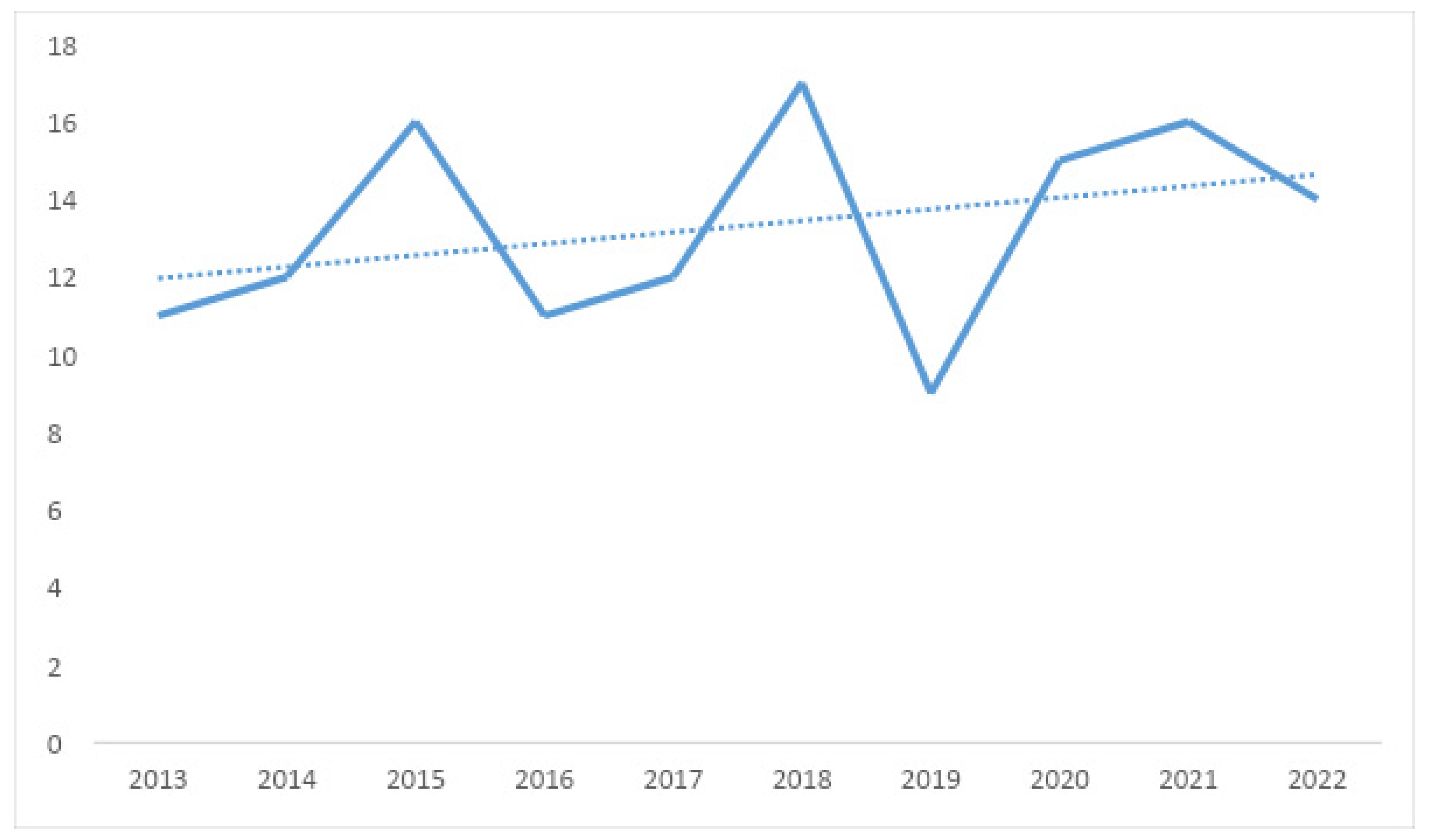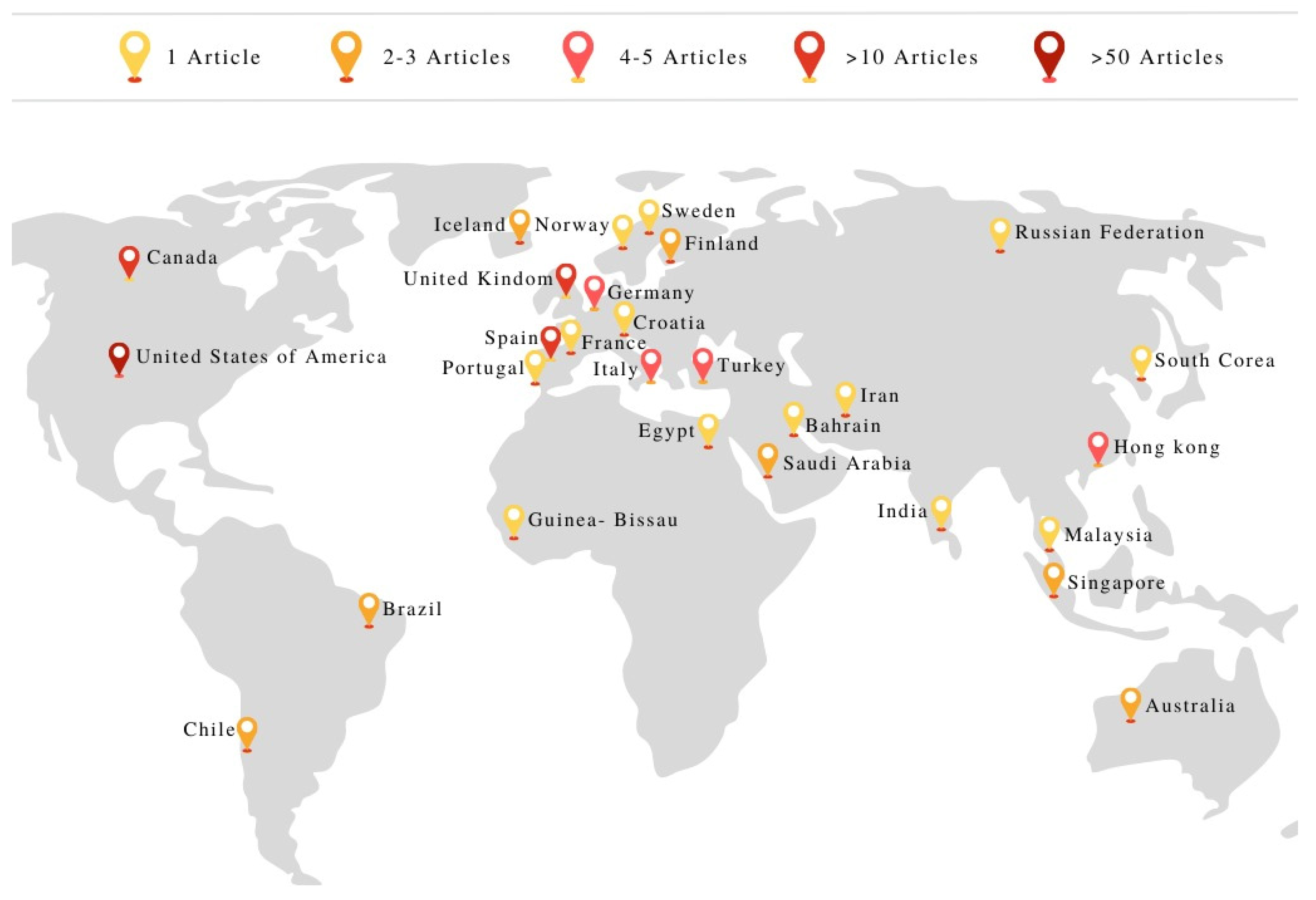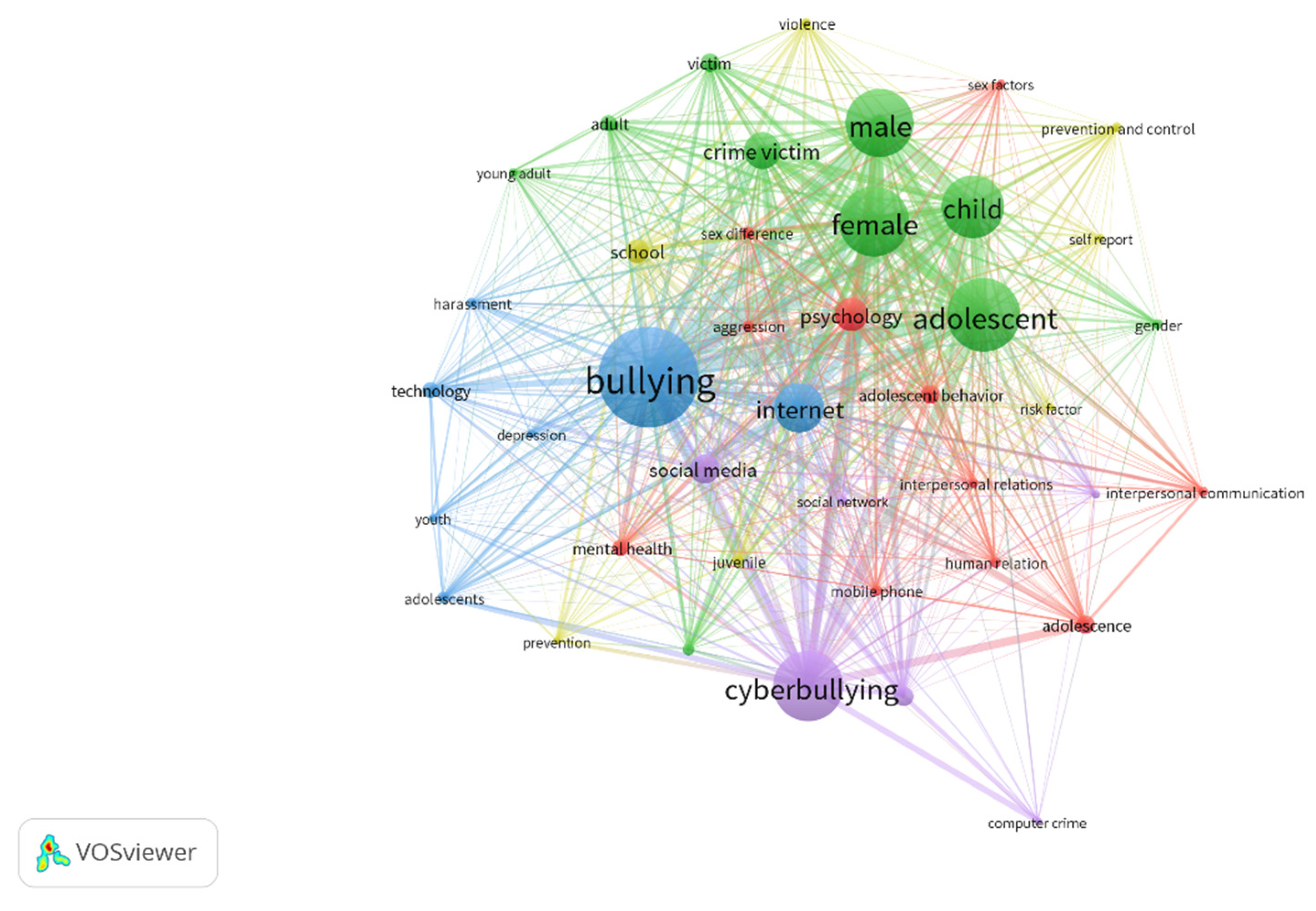Cyberbullying: Education Research
Abstract
1. Introduction
2. Method
3. Results
3.1. Bibliometric Study
3.1.1. Productivity
3.1.2. Collaboration
3.1.3. Impact
3.1.4. Dispersion
3.2. Content Analysis
3.2.1. Prevention of Cyberbullying
The Role of Technology in Cyberbullying Prevention
Analysis of Prevention Programmes and Tools
Guidelines and Recommendations
3.2.2. Assessment: Cyberbullying Questionnaires and Scales
3.2.3. Research on Cyberbullying
Prevalence of the Phenomenon
- Receiving offensive and insulting messages via mobile phone or the internet (27.2%).
- Receiving anonymous calls to frighten and provoke fear (22.2%).
- Being subjected to defamation through the internet to discredit (17.3%).
- Receiving offensive and insulting calls via mobile phone or the internet (16.3%).
- Being blackmailed or threatened by messages or calls (11.9%).
- Theft of password to prevent access to accounts (11.4%) [69] (p. 12).
Risk Factors in Cyberbullying
Victims of Cyberbullying
4. Discussion and Conclusions
Author Contributions
Funding
Institutional Review Board Statement
Informed Consent Statement
Data Availability Statement
Conflicts of Interest
References
- Serrano, A.; Iborra, I. Informe. Violencia entre Compañeros en la Escuela. Centro Reina Sofía para el Estudio de la Violencia. 2005. Available online: https://convivencia.files.wordpress.com/2012/05/informe_reina_sofia-violencia200594p.pdf (accessed on 27 February 2023).
- Bauman, S.; Cross, D.; Walker, J.L. Principles of Cyberbullying Research: Definitions, Measures, and Methodology, 1st ed.; Routledge: New York, NY, USA, 2013. [Google Scholar]
- Sánchez, L.; Crespo, G.; Aguilar, R.; Bueno, F.J.; Aleixandre, R.; Valderrama, J.C. Los Adolescentes y el Ciberacoso. Plan Municipal de Drogodependencias. Unitat de Prevenció Comunitaria de Conductes Adictives (UPCCA-Valencia). 2016. Available online: http://www.codajic.org/sites/default/files/sites/www.codajic.org/files/Los_Adolescentes_y_el_Ciberacoso.pdf (accessed on 27 February 2023).
- Camerini, A.L.; Marciano, L.; Carrara, A.; Schulz, P.J. Cyberbullying perpetration and victimization among children and adolescents: A systematic review of longitudinal studies. Telemat. Inform. 2020, 49, 101362. [Google Scholar] [CrossRef]
- John, A.; Glendenning, A.C.; Marchant, A.; Montgomery, P.; Stewart, A.; Wood, S.; Hawton, K. Self-harm, suicidal behaviours, and cyberbullying in children and young people: Systematic review. J. Med. Internet Res. 2018, 20, e129. [Google Scholar] [CrossRef]
- Larrota, K.; Esteban, R.; Ariza, Y.; Redondo, J.; Luzarzo, M. Ideación suicida en una muestra de jóvenes víctimas de cyberbullying. Psicoespacios Rev. Virtual Inst. Univ. Envigado 2018, 12, 19–34. [Google Scholar] [CrossRef]
- Quintana, D.A.; Tanori, J.; Grubits, H.B.; Vera, J.A. Percepciones del Ciberacoso, el Rol Espectador. In Violência, Gênero e Populações Vulneráveis, 1st ed.; Grubits, S., Oliveira, E., Vera, J.A., Eds.; Editora UCDB—Universidade Católica Dom Bosco: Campo Grande, Brasil, 2021; pp. 375–387. [Google Scholar]
- Marín, A.; Franco, S.; Betancur, E.; Vélez, V. Miedo y tristeza en adolescentes espectadores de cyberbullying. Vulneración de la salud mental en la era digital. Rev. Virtual Univ. Católica Norte 2020, 61, 66–82. [Google Scholar] [CrossRef]
- Subdirección General de Cooperación Territorial e Innovación Educativa. Informe del curso 2020–2021. Servicio de Atención Telefónica de Casos de Malos Tratos y Acoso en el Ámbito de los Centros Docentes del Sistema Educativo Español 2021, Ministerio de Educación y Formación Profesional. Available online: https://sede.educacion.gob.es/publiventa/d/26042/19/0 (accessed on 8 March 2023).
- Delgado, B.; Escortell, R. Sex and grade differences in cyberbullying of Spanish students of 5th and 6th grade of Primary Education. An. Psicol. 2018, 34, 472–481. [Google Scholar] [CrossRef]
- Delgado, B.; Escortell, R.; Martínez-Monteagudo, M.; Ferrández-Ferrer, A.; Sanmartín, R. Cyberbullying, Self-concept and Academic Goals in Childhood. Span. J. Psychol. 2019, 22, E46. [Google Scholar] [CrossRef]
- Feijóo, S.; O’Higgins-Norman, J.; Foody, M.; Pichel, R.; Braña, T.; Varela, J.; Rial, A. Sex Differences in Adolescent Bullying Behaviours. Psychosoc. Interv. 2021, 30, 95–100. [Google Scholar] [CrossRef]
- Pichel, R.; Foody, M.; O’Higgins-Norman, J.; Feijóo, S.; Varela, J.; Rial, A. Bullying, Cyberbullying and the Overlap: What Does Age Have to Do with It? Sustainability 2021, 13, 8527. [Google Scholar] [CrossRef]
- Bolognesi, A.; Bukhalovskaya, A. Arquitecturas tecnológico-didácticas para la construcción de aprendizajes felices, productivos y exitosos. Etic@Net 2022, 22, 216–240. [Google Scholar] [CrossRef]
- UNICEF, España. Impacto de la Tecnología en la Adolescencia. Relaciones, Riesgos y Oportunidades 2021, Universidad de Santiago de Compostela y Consejo General de Colegios Profesionales de Ingeniería en Informática. Available online: https://www.unicef.es/publicacion/impacto-de-la-tecnologia-en-la-adolescencia (accessed on 8 March 2023).
- Comisión Europea. Estrategia Europea para una Internet mejor para los niños (BIK+), [infografía]. 2022. Available online: https://digital-strategy.ec.europa.eu/en/library/european-strategy-better-internet-kids-bik-factsheet (accessed on 8 March 2023).
- Calvete, E.; Cortazar, N.; Ferández, L.; Echezarraga, A.; Beranuy, M.; León, A.; González, J.; Orue, I. Effects of a brief preventive intervention in cyberbullying and grooming in adolescents. Psychosoc. Interv. 2021, 30, 75–84. [Google Scholar] [CrossRef]
- Iranzo, B.; Ortega, J.; Carrascosa, I.; Clemente, J.A. Ajuste psicosocial de adolescentes agresores a través del teléfono móvil y de internet. Int. J. Dev. Educ. Psychol. Rev. Infad Psicol. 2019, 1, 79–92. [Google Scholar] [CrossRef]
- Pichel, R.; Feijóo, S.; Isorna, M.; Varela, J.; Rial, A. Analysis of the relationship between school bullying, cyberbullying, and substance use. Child. Youth Serv. Rev. 2022, 134, 106369. [Google Scholar] [CrossRef]
- Gabarda, C.; Cuevas, N.; Marti, A.; Rodríguez, A.; Agusti, A.I. Ciberacoso y ciberviolencia de pareja: ¿fenómenos relacionados? Behav. Psychol./Psicol. Conduct. 2021, 29, 597. [Google Scholar] [CrossRef]
- Torres, C.; Robles, J.M.; Marco, S. El Ciberacoso como Forma de Ejercer la Violencia de Género en la Juventud: Un Riesgo en la Sociedad de la Información y del Conocimiento 2014, Delegación del Gobierno para la Violencia de Género. Ministerio de Sanidad, Servicios Sociales e Igualdad. Available online: https://violenciagenero.igualdad.gob.es/violenciaEnCifras/estudios/colecciones/estudio/ciberacoso.htm (accessed on 13 March 2023).
- Van Raan, A. Measuring Science: Basic principles and application of advanced bibliometrics. In Springer Handbook of Science of Echnology Indicators; Glänzel, W., Moed, H.F., Schmoch, U., Thelwall, M., Eds.; Springer: Berlin/Heidelberg, Germany, 2019; pp. 237–280. [Google Scholar] [CrossRef]
- Hernández-González, V.; Sans-Rosell, N.; Jové-Deltell, M.C.; Reverter-Masia, J. Comparación entre Web of Science y Scopus, estudio bibliométrico de las revistas de anatomía y morfología. Int. J. Morphol. 2016, 34, 1369–1377. [Google Scholar] [CrossRef]
- Urrútia, G.; Bonfill, X. Declaración PRISMA: Una propuesta para mejorar la publicación de revisiones sistemáticas y metaanálisis. Med. Clínica 2010, 135, 507–511. [Google Scholar] [CrossRef]
- Lincoln, Y.S.; Guba, E.G. Naturalistic Inquiry; SAGE: California, CA, USA, 1985. [Google Scholar]
- Van Eck, N.J.; Waltman, L. Text mining and visualization using VOSviewer. arXiv 2011, arXiv:1109.2058v1. [Google Scholar]
- Cerón, M.A.; Eisman, L.B.; Palomares, F.F. Grooming, cyberbullying and sexting in Chile according of sex and school management or administrative dependency. Rev. Chil. Pediatr. 2018, 89, 352–360. [Google Scholar] [CrossRef]
- González, B. Cyberbullying at school. Rev. Enferm. 2013, 36, 16–21. [Google Scholar]
- Paniagua, H. Impact of information technology and communication. Pediatr. Integr. 2013, 17, 686–693. [Google Scholar]
- Paniagua, H. The impact of the screens: Television, computer and videogames. Pediatr. Integr. 2018, 22, 178–186. [Google Scholar]
- Cauchie, J.; Corriveau, P. La cyberintimidation à l’épreuve du milieu scolaire québécois: Regards d’intervenants sur l’irruption des nouvelles technologies à l’école. Can. J. Criminol. Crim. Justice 2015, 57, 503–527. [Google Scholar] [CrossRef]
- Verhaeghe, G. School cyber-bullying: A new violence rapidly developing. J. Med. Leg. Droit. Med. 2014, 57, 49–54. [Google Scholar]
- Pereira, M.; Fernandes, O.M.; Relva, I.C. Cyberbullying, suicidal ideation and parent-child communication in adolescents and young adults. Av. Psicol. Latinoam. 2022, 40, 1–20. [Google Scholar] [CrossRef]
- Rodríguez-Álvarez, J.M.; Navarro, R.; Yubero, S. Relationship of social integration and leisure experiences with bullying in primary school students. Pedagog. Soc. 2021, 11, 686–696. [Google Scholar] [CrossRef]
- Coluccia, A.; Ferretti, F.; Spacone, D.; Gualtieri, G.; Lorenzi, L.; Carabellese, F.; Buracchi, T.; Masti, A.; Pozza, A. Distinctive features, prevention and intervention strategies on cyberbullying in Italy. Rass. Ital. Criminol. 2021, 15, 30–39. [Google Scholar]
- Kinnunen, M.; Ervasti, M.; Jutila, M.; Pantsar, S.; Sesay, A.M.; Pääkkönen, S.; Mäki, M.; Mian, S.Q.; Oinas-Kukkonen, H.; Oduor, M.; et al. Improving the well-being and safety of children with sensors and mobile technology. J. Technol. Hum. Serv. 2016, 34, 359–375. [Google Scholar] [CrossRef]
- Holt, T.J.; Fitzgerald, S.; Bossler, A.M.; Chee, G.; Ng, E. Assessing the risk factors of cyber and mobile phone bullying victimization in a nationally representative sample of singapore youth. Int. J. Offender Ther. Comp. Criminol. 2016, 60, 598–615. [Google Scholar] [CrossRef]
- Holt, T.J.; Chee, G.; Ng, E.A.H.; Bossler, A.M. Exploring the consequences of bullying victimization in a sample of singapore youth. Int. Crim. Justice Rev. 2013, 23, 25–40. [Google Scholar] [CrossRef]
- Gómez-Galán, J. Media education in the ICT era: Theoretical structure for innovative teaching styles. Information 2020, 11, 276. [Google Scholar] [CrossRef]
- Mitchell, K.J.; Segura, A.; Jones, L.M.; Turner, H.A. Poly-victimization and peer harassment involvement in a technological world. J. Interpers Violence 2018, 33, 762–788. [Google Scholar] [CrossRef]
- Reisner, S.L.; Greytak, E.A.; Parsons, J.T.; Ybarra, M.L. Gender minority social stress in adolescence: Disparities in adolescent bullying and substance use by gender identity. J. Sex Res. 2015, 52, 243–256. [Google Scholar] [CrossRef] [PubMed]
- Zweig, J.M.; Dank, M.; Yahner, J.; Lachman, P. The rate of cyber dating abuse among teens and how it relates to other forms of teen dating violence. J. Youth Adolesc. 2013, 42, 1063–1077. [Google Scholar] [CrossRef] [PubMed]
- Hinduja, S.; Patchin, J.W. Social influences on cyberbullying behaviors among middle and high school students. J. Youth Adolesc. 2013, 42, 711–722. [Google Scholar] [CrossRef]
- Mitchell, K.J.; Jones, L.M.; Turner, H.A. Past year technology-involved peer harassment victimization and recent depressive symptoms and suicide ideation among a national sample of youth. J. Interpers Violence 2021, 36, NP1165–NP1179. [Google Scholar] [CrossRef]
- Mitchell, K.J.; Jones, L.M.; Turner, H.A.; Shattuck, A.; Wolak, J. The role of technology in peer harassment: Does it amplify harm for youth? Psychol. Violence 2016, 6, 193–204. [Google Scholar] [CrossRef]
- Price-Feeney, M.; Jones, L.M.; Ybarra, M.L.; Mitchell, K.J. The relationship between bias-based peer victimization and depressive symptomatology across sexual and gender identity. Psychol. Violence 2018, 8, 680–691. [Google Scholar] [CrossRef]
- Wells, M.; Mitchell, K.J.; Jones, L.M.; Turner, H.A. Peer harassment among youths with different disabilities: Impact of harassment online, in person, and in mixed online and in-person incidents. Child. Sch. 2019, 41, 17–24. [Google Scholar] [CrossRef]
- Ybarra, M.L.; Espelage, D.L.; Mitchell, K.J. Differentiating youth who are bullied from other victims of peer-aggression: The importance of differential power and repetition. J. Adolesc. Health 2014, 55, 293–300. [Google Scholar] [CrossRef] [PubMed]
- Abreu, L.D.P.; Torres, R.A.M.; Veras, K.D.C.B.B.; Araújo, A.F.; Costa, I.G.; Oliveira, G.R. Web radio: Educational nursing care technology addressing cyberbullying students’ statements. Rev. Bras. Enferm. 2020, 73, e20180872. [Google Scholar] [CrossRef]
- Al-Khateeb, H.M.; Epiphaniou, G. How technology can mitigate and counteract cyber-stalking and online grooming. Comput. Fraud Secur. 2016, 1, 14–18. [Google Scholar] [CrossRef]
- Bickham, D.S.; Moukalled, S.; Inyart, H.K.; Zlokower, R. Evaluating a middle-school digital citizenship curriculum (screenshots): Quasi-experimental study. JMIR Ment. Health 2021, 8, e26197. [Google Scholar] [CrossRef] [PubMed]
- Ferri, F.; D’Andrea, A.; D’Ulizia, A.; Grifoni, P. Co-creation of e-learning contenti the case study of a MOOC on health and cyber-bullying. J. Univers. Comput. Sci. 2020, 26, 200–219. [Google Scholar] [CrossRef]
- Gabrielli, S.; Rizzi, S.; Carbone, S.; Donisi, V. A chatbot-based coaching intervention for adolescents to promote life skills: Pilot study. JMIR Hum. Factors 2020, 7, e16762. [Google Scholar] [CrossRef]
- Leff, S.S.; Waasdorp, T.E.; Paskewich, B.S.; Bevans, K.B.; Winston, K. The Free2B multi-media bullying prevention experience: An exemplar of scientific edutainment. Front. Psychiatry 2020, 11, 679. [Google Scholar] [CrossRef]
- Leff, S.S.; Waasdorp, T.E.; Paskewich, B.S.; Winston, F.K. Scaling and disseminating brief bullying prevention programming: Strengths, challenges, and considerations. Sch. Psychol. Rev. 2021, 50, 454–468. [Google Scholar] [CrossRef] [PubMed]
- Calvo-Morata, A.; Rotaru, D.C.; Alonso-Fernández, C.; Freire-Morán, M.; Martinez-Ortiz, I.; Fernández-Manjón, B. Validation of a cyberbullying serious game using game analytics. IEEE Trans. Learn. Technol. 2020, 13, 186–197. [Google Scholar] [CrossRef]
- Przybylski, A.K.; Nash, V. Internet filtering technology and aversive online experiences in adolescents. J. Pediatr. 2017, 184, 215–219.e1. [Google Scholar] [CrossRef][Green Version]
- Edgerton, E.; Reiney, E.; Mueller, S.; Reicherter, B.; Curtis, K.; Waties, S.; Limber, S.P. Identifying new strategies to assess and promote online health communication and social media outreach: An application in bullying prevention. Health Promot. Pract. 2016, 17, 448–456. [Google Scholar] [CrossRef] [PubMed]
- Good, B.; Fang, L. Promoting smart and safe internet use among children with neurodevelopmental disorders and their parents. Clin. Soc. Work J. 2015, 43, 179–188. [Google Scholar] [CrossRef]
- Ozansoy, K. Developing strategies for the prevention of cyberbullying in secondary education. Ponte 2017, 73, 34–42. [Google Scholar] [CrossRef]
- Gámez-Guadix, M.; Villa-George, F.; Calvete, E. Psychometric properties of the cyberbullying questionnaire (CBQ) among mexican adolescents. Violence Vict. 2014, 29, 232–247. [Google Scholar] [CrossRef]
- Betts, L.R.; Houston, J.E.; Steer, O.L. Development of the multidimensional peer victimization scale-revised (MPVS-R) and the multidimensional peer bullying scale (MPVS-RB). J. Genet. Psychol. 2015, 176, 93–109. [Google Scholar] [CrossRef]
- Sumter, S.R.; Valkenburg, P.M.; Baumgartner, S.E.; Peter, J.; Van Der Hof, S. Development and validation of the multidimensional offline and online peer victimization scale. Comput. Hum. Behav. 2015, 46, 114–122. [Google Scholar] [CrossRef]
- Breivik, K.; Olweus, D. An item response theory analysis of the olweus bullying scale. Aggress. Behav. 2015, 41, 1–13. [Google Scholar] [CrossRef]
- Trbojević, F.; Šikuten, L. Prevalence, forms, and predictors of cyberbullying perpetration. [Prevalencija, oblici i prediktori elektroničkog nasilja]. Medijska Istraz. 2022, 28, 133–154. [Google Scholar] [CrossRef]
- Feijóo, S.; Foody, M.; Norman, J.O.; Pichel, R.; Rial, A. Cyberbullies, the cyberbullied, and problematic internet use: Some reasonable similarities. [Ciberacosados, ciberacosadores y uso problemático de internet: Algunos parecidos razonables]. Psicothema 2021, 33, 198–205. [Google Scholar] [CrossRef] [PubMed]
- González-Calatayud, V.; Prendes-Espinosa, M.P. Role-based cyberbullying situations: Cybervictims, cyberaggressors and cyberbystanders. Int. J. Environ. Res. Public Health 2021, 18, 8669. [Google Scholar] [CrossRef] [PubMed]
- González-Calatayud, V. Victims of cyberbullying in the region of Murcia: A growing reality. J. New Approaches Educ. Res. 2018, 7, 10–16. [Google Scholar] [CrossRef]
- Moro, Á.; Ruiz-Narezo, M.; Fonseca, J. Use of social networks, video games and violent behaviour in adolescence among secondary school students in the basque country. BMC Psychol. 2022, 10, 241. [Google Scholar] [CrossRef] [PubMed]
- Catone, G.; Senese, V.P.; Pisano, S.; Siciliano, M.; Russo, K.; Muratori, P.; Broome, M.R. The drawbacks of information and communication technologies: Interplay and psychopathological risk of nomophobia and cyber-bullying, results from the bullying and youth mental health naples study (BYMHNS). Comput. Hum. Behav. 2020, 113, 106496. [Google Scholar] [CrossRef]
- Tao, S.; Reichert, F.; Law, N.; Rao, N. Digital technology use and cyberbullying among primary school children: Digital literacy and parental mediation as moderators. Cyberpsychol. Behav. Soc. Netw. 2022, 25, 571–579. [Google Scholar] [CrossRef]
- Paez, G.R. Assessing predictors of cyberbullying perpetration among adolescents: The influence of individual factors, attachments, and prior victimization. Int. J. Bullying Prev. 2020, 2, 149–159. [Google Scholar] [CrossRef]
- Sasson, H.; Mesch, G. The role of parental mediation and peer norms on the likelihood of cyberbullying. J. Genet. Psychol. 2017, 178, 15–27. [Google Scholar] [CrossRef]
- Beltrán-Catalán, M.; Zych, I.; Ortega-Ruiz, R.; Llorent, V.J. Victimisation through bullying and cyberbullying: Emotional intelligence, severity of victimisation and technology use in different types of victims. Psicothema 2018, 30, 183–188. [Google Scholar] [CrossRef]
- de Faria, M.A.; Gomes, M.C.A.; Modena, C.M. “Sea of bullying”: A whirlwind of violence against lesbians, gays, bisexuals, transvestites, and transsexuals at school. Educ. Pesqui. 2022, 48, e241630. [Google Scholar] [CrossRef]
- Cénat, J.M.; Hébert, M.; Blais, M.; Lavoie, F.; Guerrier, M.; Derivois, D. Cyberbullying, psychological distress and self-esteem among youth in Quebec schools. J. Affect. Disord. 2014, 169, 7–9. [Google Scholar] [CrossRef]
- Chen, B.; Luppicini, R. The new era of bullying: A phenomenological study of university students’ past experience with cyberbullying. Int. J. Cyber Behav. Psychol. Learn. 2017, 7, 72–90. [Google Scholar] [CrossRef]
- Hamby, S.; Blount, Z.; Taylor, E.; Mitchell, K.; Jones, L. The association of different cyber-victimization types with current psychological and health status in southern appalachian communities. Violence Vict. 2021, 36, 251–271. [Google Scholar] [CrossRef]
- Betts, L.R.; Spenser, K.A.; Baguley, T. Describing disclosure of cybervictimization in adolescents from the United Kingdom: The role of age, gender, involvement in cyberbullying, and time spent online. J. Genet. Psychol. 2022, 183, 40–53. [Google Scholar] [CrossRef]
- Green, M.; Bobrowicz, A.; Ang, C.S. The lesbian, gay, bisexual and transgender community online: Discussions of bullying and self-disclosure in YouTube videos. Behav. Inf. Technol. 2015, 34, 704–712. [Google Scholar] [CrossRef]
- Marín-Suelves, D.; Esnaola-Horacek, G.; Donato, D. Videojuegos y educación: Análisis de tendencias en investigación. Rev. Colomb. Educ. 2022, 1, 1–17. [Google Scholar] [CrossRef]
- Quintero-Quintero, W.; Arévalo-Ascanio, J.G.; Navarro-Claro, G.T. Acoso escolar: Un análisis bibliométrico. Mundo FESC 2021, 11, 64–77. [Google Scholar]
- Stephan, F.; Aparecida, A.; Soares, F.; Xavier, L.; Moura, L. Bullying e aspectos psicossociais: Estudo bibliométrico. Temas Psicol. 2013, 21, 245–258. [Google Scholar] [CrossRef]
- Ruíz, C.; Méndez, I.; Martínez, J.P.; Cerezo, F. Análisis bibliométrico de la investigación en cyberbullying en España o junto a otros países. Anu. Psicol./UB J. Psychol. 2020, 50, 38–46. [Google Scholar] [CrossRef]
- Herrera-López, M.; Romera, E.M.; Ortega-Ruiz, R. Bullying y Cyberbullying en Latinoamérica. Un estudio bibliométrico. Rev. Mex. Investig. Educ. 2018, 23, 125–155. [Google Scholar]
- López, S.; Rial, A.; Marín-Suelves, D.; Rodríguez, J. Videojuegos, salud, convivencia y adicción: ¿Qué dice la evidencia científica? Psychol. Soc. Educ. 2022, 14, 45–54. [Google Scholar] [CrossRef]
- Digón-Regueiro, P.; Castro, M.M.; Rodríguez, A. Menores influencers y la importancia de una alfabetización mediática crítica. EDMETIC 2023, 12, 7. [Google Scholar] [CrossRef]




| Indicators | Categories of Analysis |
|---|---|
| Productivity | Number of publications by date, field, country, and language. |
| Collaboration | Authors and networks. |
| Impact | Number of citations, producers, journals, and impact index. |
| Dispersion | Distribution by zones. |
| Category | Sub-Category |
|---|---|
| Prevention of cyberbullying | The role of technology; analysis of prevention programmes and tools; and guidelines and recommendations. |
| Assessment: Cyberbullying questionnaires and scales | |
| Research on cyberbullying | Prevalence; risk factors; victims. |
| No. of Authors | No. of Documents |
|---|---|
| 1 | 15.3% |
| 2 | 22.1% |
| 3 | 22.9% |
| 4 | 16.8% |
| ≥5 | 22.9% |
| No. of Citations | No. of Documents |
|---|---|
| 0 | 15 |
| 1–20 | 72 |
| 21–40 | 18 |
| 41–60 | 14 |
| 61–80 | 2 |
| 81–100 | 1 |
| >100 | 9 |
| Paper | Journal | No. of Citations |
|---|---|---|
| [41] | Journal of Sex Research | 290 |
| [42] | Journal of Youth and Adolescence | 275 |
| [43] | Journal of Youth and Adolescence | 228 |
| Journals | Papers | Cumulative Citations | Impact Index |
|---|---|---|---|
| Computers in Human Behavior | 7 | 291 | 41.6 |
| Journal of Interpersonal Violence | 6 | 118 | 19.7 |
| Journal of Youth and Adolescence | 5 | 790 | 158 |
Disclaimer/Publisher’s Note: The statements, opinions and data contained in all publications are solely those of the individual author(s) and contributor(s) and not of MDPI and/or the editor(s). MDPI and/or the editor(s) disclaim responsibility for any injury to people or property resulting from any ideas, methods, instructions or products referred to in the content. |
© 2023 by the authors. Licensee MDPI, Basel, Switzerland. This article is an open access article distributed under the terms and conditions of the Creative Commons Attribution (CC BY) license (https://creativecommons.org/licenses/by/4.0/).
Share and Cite
Marín Suelves, D.; Rodríguez Guimeráns, A.; Romero Rodrigo, M.M.; López Gómez, S. Cyberbullying: Education Research. Educ. Sci. 2023, 13, 763. https://doi.org/10.3390/educsci13080763
Marín Suelves D, Rodríguez Guimeráns A, Romero Rodrigo MM, López Gómez S. Cyberbullying: Education Research. Education Sciences. 2023; 13(8):763. https://doi.org/10.3390/educsci13080763
Chicago/Turabian StyleMarín Suelves, Diana, Ana Rodríguez Guimeráns, Mª Mercedes Romero Rodrigo, and Silvia López Gómez. 2023. "Cyberbullying: Education Research" Education Sciences 13, no. 8: 763. https://doi.org/10.3390/educsci13080763
APA StyleMarín Suelves, D., Rodríguez Guimeráns, A., Romero Rodrigo, M. M., & López Gómez, S. (2023). Cyberbullying: Education Research. Education Sciences, 13(8), 763. https://doi.org/10.3390/educsci13080763








